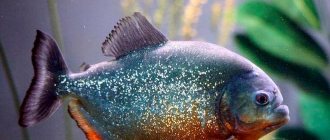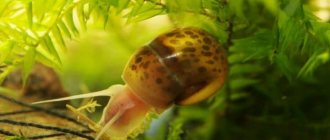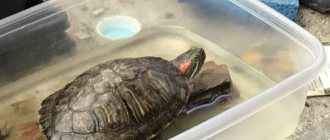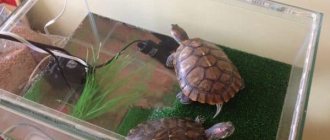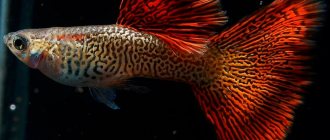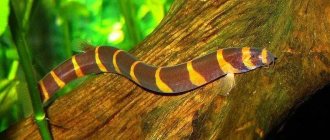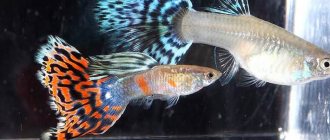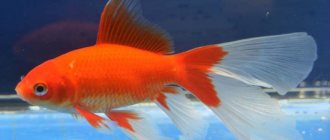Decorative reptiles are loved not only by children, but also by adults. They do not cause discomfort in the form of fur on furniture and carpets, do not require being walked twice a day, and do not run around in a rattling wheel. Many species of small turtles are calm, quiet and hardy, but this does not mean that caring for them can be left to chance.
The closer the living conditions and the more varied the diet, the longer your exotic pet will live. Let's figure out what types there are, how long small turtles can live in captivity, what to feed and how to keep them.
Main types
The species united by the common name “waterfowl turtle” are divided into:
- closing;
- flat;
- spotted;
- Chinese.
Closing
The species of secluded aquatic turtles is represented by the following subspecies:
- mud red-cheeked;
- mud walleye;
- musky keel;
- common musk.
The natural habitat of aquatic turtles of this species is the coasts of South and North America. All animals have a spherical carapace - a rib-shaped spine of the neck plate, which in case of danger the reptile tightly closes, thereby gaining complete protection.
Interestingly, the subspecies of mud turtles has developed dense membranes between the toes on the front and hind legs. Animals in nature rarely grow more than 15 centimeters in length, and the bulk of the diet consists of food of animal origin.
Flat
The species of flathead aquatic turtles has several subspecies of Homopus:
- boulengeri;
- areolatus;
- signatus;
- femoralis;
- solus.
Animals of this species are distinguished by a strongly elongated skull, and in adulthood they rarely exceed 10 centimeters in length. The head is proportional, there are special small protective shields on the neck, the carapace is convex, oval in shape, slightly extended forward. The shades of carapace range from dark brown to olive. Females are larger than males and lay up to 5 eggs in one clutch.
Spotted
A species of true amphibians, spotted water turtles are characterized by a unique ability to thrive only in tandem conditions of land and water in the conditions of their urban home. The aquarium of such an animal must be equipped with an island of land, on which the turtle will happily rest and also bask under the rays of a special heating lamp. The length of the reptile rarely exceeds 13 centimeters.
Chinese three-keel
Chinese turtles are most often found among new breeders. These wonderful animals are considered the easiest to keep and undemanding in terms of diet diversity. A water house with a volume of about 100 liters is suitable for this reptile, because the size of an adult individual of this species is only 12 centimeters.
Content Benefits
Waterfowl turtles are kept at home primarily due to their simplicity and ease of care.
It is customary to highlight the following advantages of the content:
- Unpretentiousness. To live together in a city apartment, it is enough to equip the turtle with an aquaterrarium that is optimal in terms of water temperature and lighting, and do not forget to feed it on time and correctly.
- Inexpensive food. An adult turtle is fed 2 - 4 times a week.
- Calm and peaceful character. The animal does not make loud sounds and does not require attention.
- Longevity. A rare pet can boast an average life expectancy of 30 - 40 years. In addition, turtles are very persistent and hardy animals, are little susceptible to diseases and infections, and perfectly adapt to climatic conditions.
- Safety. The reptile will not bite or scratch, and you can trust a child to care for it, but in this case, you need to explain the basic rules of maintenance and care, and also control that a curious child does not accidentally harm the turtle.
Where to keep a mini turtle
For the normal existence and development of an aquatic miniature turtle, you will need a 100-150 liter aquarium. As for the land species, a small terrarium is enough. At the same time, you need to know about the minimum and maximum temperatures so that your pet feels comfortable. It’s also a good idea to know about his diet. You need to know that all pet turtles are representatives of hot countries that need suitable temperature and humidity. Only with this approach will your pet be always healthy and delight others with its activity.
If these conditions are violated, then you need to be prepared for very unpleasant surprises. You should know that it is better to prevent negative consequences than to get rid of them later. The first thing that can happen is that the turtle gets sick, and treating such a baby, especially on your own, is very difficult and you can’t do it without a specialist herpetologist. And this, after all, is not only a loss of precious time, but also a waste of money. At the same time, we should not forget about the psychological aspect.
Conditions of detention
You need to create an aquatic home for an animal based on the type of turtle, since each has its own nuances.
Keeping turtles in an aquarium comes down to meeting the general and basic requirements for aquatic turtles:
- an aquarium with a volume of at least 50 liters;
- presence of heat and light sources;
- a sufficient amount of food needed for a particular type of food.
Requirements for an aquarium
Only a horizontal terrarium is suitable for a turtle, since animals prefer to swim longer. Although the depth is of little importance for reptiles of this class, it is worth paying attention that the height of the container should be at least 30-40 centimeters. The material of the house should be durable glass or plastic, but it must be non-toxic. If a completely enclosed aquarium is intended, ventilation must be provided. Tap water is also suitable for filling, but it is better to use settled water and pour a volume that covers a little more than half the container.
Important! There is an interesting calculation of the length of its aquatic house required for an animal: the length of the aquarium should be 7-8 times the length of the shell of an adult animal.
To see the locking turtles, you need a glass house with at least 50 liters of water. It is recommended to line the bottom with bulk soil and plant several underwater plants - this way the animal will live in conditions close to natural conditions. Be sure to build a shelter at the bottom, it can be a piece of driftwood or a clay pot, or any other decorative element will do, the main thing is that it fulfills its main function - protection, and the reptile fits well in it.
Flatback turtles are a little more demanding in terms of living conditions, and they must be taken care of in a special way, otherwise the animal is unlikely to survive for long. This species cannot be kept together with other species. An aquarium with a volume of 50 liters or more is lined with small pebbles along the bottom, a layer of about 2 centimeters.
Spotted turtles need a container with a volume of 70 liters or more. Among all aquatic turtles, they are considered the most active, so it is necessary to provide sufficient space for swimming. The bottom is lined with gravel; underwater plants would be useful.
For Chinese turtles, not just an aquarium is created, but a real house with a volume of 100 liters or more. An island of land must be built on which several large stones are placed so that in the future they can be heated with a heat lamp. The bottom must be lined with soil, several underwater plants are planted, and decorative elements are installed.
Important! Amphibians, or semi-aquatic species, the Chinese and red-eared turtles, can easily leave their home over the rocks of a land island and go on a walking journey around the apartment. To prevent this from happening, it is recommended to cover the part of the aquarium with dry land with glass or a special lid.
Necessary equipment
The terrarium must be equipped with the following elements:
- Submersible heater for maintaining a constant temperature in the aquarium, on average from 20 to 25 degrees, depending on the type of animal and time of year. A device made of glass or plastic is immersed in water. A plastic device is preferable - it is stronger, has a safe suction cup, and the reptile will not get burned on it if it touches it.
- Thermometer for constant monitoring of the temperature in the terrarium.
- A water filter can be connected to an aeration device; it is necessary to purify water and enrich it with oxygen. The air tube of the aerator must be brought to the surface.
- A light lamp with a timer is necessary for the proper organization of daylight hours (from 9 to 13 hours, depending on the time of year and the type of animal).
- Land surface for semi-aquatic turtles. An island of land in an aquarium is, without a doubt, mandatory, but it is no less preferable for aquatic ones - there the animal can rest and warm up.
Temperature
For a specific subspecies, a certain temperature is set. The average is from 20 to 26 degrees.
land turtle
The most common type of land turtle is the Central Asian one. As the name suggests, it lives in Central Asia and is a heat-loving species. These animals are listed in the Red Book and are most often smuggled. Despite this, and perhaps because of this, they are the most common species found in ordinary homes.
Some turtle owners are irresponsible about keeping the animal; they keep it on the floor in winter, sometimes without even knowing which radiator the turtle is warming itself under. This is extremely harmful for the animal! It is enough to look at photographs of mutilated turtles, with rickety shells, with cracks in the carapace from exposure to furniture, to understand that it is necessary to create suitable climatic conditions for the animal.
Here we will tell you how to care for a land turtle. It is necessary to place it in a terrarium, provide bathing, walks, food and ultraviolet radiation, as well as an incandescent lamp.
Care
A water turtle at home, of course, requires constant care, albeit not energy-consuming.
Basic principles of care:
- it is necessary to monitor the behavior of the reptile and its state of health daily;
- make sure that the water in the terrarium remains clean and change it on time;
- when changing the water in the terrarium, it is necessary to thoroughly rinse all decorative elements;
- replace gravel in a timely manner and ensure its cleanliness;
- feed the animal in accordance with the requirements of the species, on time;
- enrich the diet with special mineral supplements;
- start treatment in a timely manner if alarming symptoms occur.
The class of aquatic aquarium turtles is really undemanding in care and maintenance.
What to look for when purchasing
Aquatic turtles are quite active creatures. A healthy animal shows interest in everything that is happening, eats well, and its reflexes work perfectly (for example, in case of the slightest danger, the reptile quickly hides in its shell). It is recommended to purchase a turtle from a trusted pet store or nursery, where there is no doubt about the living conditions created for the animals. When purchasing, the main criteria for evaluating a turtle will be its activity and appearance.
A properly raised young reptile has the following characteristics:
- smooth and clean shell without plaque or damage;
- clear, clean eyes, without wounds and suppuration;
- active swimming;
- good reflexes and movement of limbs.
It is also worth noting that a truly healthy animal is simply pleasant to look at.
Important! Aquarium turtles that live with fish should be small, and the fish, accordingly, should be large enough so that they are not perceived as food by the reptiles.
How to pick up
To communicate with an animal, you need to learn how to hold it correctly. The turtle is picked up under the belly, if it is small, and held in the palm of your hand, while larger animals are taken with both hands on the sides of the shell and be sure to grab the belly.
A turtle, like any animal, needs to be taught to be touched gradually. If your pet hisses or tries to hide, you should not force him to communicate. When the animal has become accustomed to the owner and his hands, you can sit him on your hand or knee, but it is not advisable to keep him in a canopy for a long time - this is unpleasant for turtles.
Changing water
The amount of water is indicated in the requirements for keeping the species, but the general criterion for quality is purity. Accordingly, the water should be changed at least once a month, and more often if it is heavily polluted.
Hibernation
It is extremely difficult to properly hibernate a reptile at home. If the animal is active and does not show signs of wanting to “winter”, you should not artificially create conditions for it. Improper hibernation can cause irreparable harm to the body.
What to look for when purchasing
If you can identify a healthy puppy, kitten or even a parrot with the naked eye, then with reptiles everything is a little more complicated. The criteria are similar: the animal must be active, eat well and show curiosity.
You should make sure that he has a clean and smooth shell without damage or plaque, clear eyes without signs of infection or pus, and good reflexes.
Active swimming is also a sign of a healthy individual. It is better to take turtles from a trusted nursery or pet store.
If you add fish to the aquarium with them, it is recommended to add larger ones so that they are not perceived by the turtles as potential food.
Feeding
A turtle's diet is based on the needs of a particular species. The majority is food of animal origin, supplemented by permitted vegetables. You can feed turtles with special dry food, but only high-quality food and no more than once a week.
Fish and seafood
What is the best way to feed a turtle? The basis of nutrition for waterfowl turtles of any kind is low-fat small fish. Live is preferred, but not required.
The following types are suitable:
- cod;
- hake;
- perch;
- crucian carp
Fish caviar (raw!) is a real delicacy for turtles; it can and should also be offered to your pets.
It is not recommended to feed turtles with fatty fish, such as:
- capelin;
- sprat;
- sprat
The diet will also be enriched with raw seafood:
- squid;
- crabs;
- crayfish;
- shrimps;
- mussels;
- scallops;
- octopuses.
Plant food
You can give it no more than twice a week, preferably less often.
Suitable:
- dandelion leaf, plantain leaf;
- lettuce and cabbage;
- seaweed (dry);
- apples, bananas, pears;
- carrots, cucumbers, pumpkin.
Meat
Once a week you are allowed to treat your turtle to lean poultry or lean beef. It is more beneficial to give chicken or beef liver in small quantities.
Insects
The following insects are suitable in dry or fresh (even live) form:
- zoophobus;
- mealworm;
- cricket;
- locusts;
- snails;
- bloodworm;
- gammarus;
- earthworms;
- cockroaches (ash, periplanets);
- wax moth larvae;
It is not advisable to feed a turtle this food more than once a week, and it is allowed to feed moth larvae no more than once a month.
Where to feed, how often
It is recommended to organize feeding in the same place in the aquarium. The amount of food given to the animal at one time should be eaten by it within 20 minutes. As soon as the reptile begins to get distracted and scatter pieces of food, it means it has had enough and no longer needs it. It is recommended to remember this volume.
Babies are fed daily, often twice a day, dividing the daily amount of food into morning feeding and evening feeding, and adults are fed in one meal every two or three days.
Prohibited Products
It is strictly forbidden to feed your turtle food that has undergone heat treatment, especially fried food.
The following should not be included in the diet:
- spinach;
- peas;
- radish;
- cauliflower;
- mushrooms;
- pineapples;
- citrus fruit;
- nuts;
- porridge;
- dairy and fermented milk products;
- bakery products;
- crab sticks.
It is also prohibited to give seeds and seeds of permitted fruits and vegetables.
What to feed aquarium turtles
Caring for small turtles is quite simple.
The main condition for a comfortable life in captivity is proper and varied nutrition. What do aquatic turtles eat and how often should they be fed? Let's figure it out. Despite the fact that aquatic inhabitants can spend a long time on land, sitting on branches or stones, they need to be fed only in water. Remember, if your pet is no more than 10 cm in length, you need to feed it daily; if you are over 10 cm, you need to feed it once every three days.
What kind of food can be offered to the animal:
In addition to amphibians, turtles can be given worms, slugs, snails, and beetles. Don't forget about mineral supplements. These can be pharmaceutical drugs, crushed eggshells or bone meal.
Many people prefer to feed their exotic animals exclusively with dry food. But it's not right. Proper feeding corresponds to natural food rich in energy, vitamins and microelements.
Reproduction
Mating occurs in conditions of satiety, warmth and humidity all year round. It is recommended, a couple of months before the expected mating season, to place males and females in different enclosures, and preferably rooms, so that the animals do not see each other. It is recommended to place males with females.
A turtle's pregnancy can last from a week to two months. If the female is not satisfied with the conditions for laying eggs, she is restless and may refuse to eat. A few days before laying, the female will begin to look for a suitable place and dig the soil. It is recommended to organize a special box.
Eggs can be different in shape, round and oval, white and yellowish. Incubation of eggs lasts about two months. It is strongly recommended to move the eggs into a special incubator and check them daily for spoilage - rotten eggs may appear and ruin the entire clutch. The female is not interested in the clutch; further care of the babies falls on the owner.
How to determine gender
Gender is established at the stage of embryo formation in the egg. However, in most cases it is possible to accurately determine sex only after the animal reaches sexual maturity and the appearance of secondary sexual characteristics. Typically, at home, a turtle reaches maturity at the age of 2.5 to 5 years, depending on the species and conditions of detention.
There are a number of procedures that can help reveal gender earlier, such as:
- blood test for a certain number of hormones;
- radiography;
- Ultrasound;
- endoscopy.
Often such studies are uninformative and costly, and are resorted to in especially rare cases.
Let's look at how the sex of an animal is determined based on secondary sexual characteristics.
Carapace
In males: elongated, narrow, concave, quite high, noticeably smaller than in females, the posterior end has a V-shaped appearance.
In females: rounded, short, relatively flat, noticeably larger in size, the rear end is rounded.
Tail
In males: long and thin, the cloaca is located 1/3 from the edge of the shell, and looks like a longitudinal line.
In females: short and thick, the cloaca is located close to the carapace, has the appearance of an asterisk.
Limbs
In males: the claws are curved and long, quite sharp, the forelimbs are slightly longer than those of females, and well-defined femoral spurs.
In females: the limbs are shorter and more massive than in males, the claws are short and blunt.
Head
In males: the head is larger, the nose is sharper.
In females: the head is smaller than that of males, and the nose is not so pointed.
Important! Depending on the species, males and females differ in eye color.
It is also worth noting that male aquatic turtles can “show off their voice” - squeak to attract attention. They are more active than females and can show some aggression and chase other turtles even at a fairly young age.
Taking care of your health
Compliance with all the rules for the care and maintenance of waterfowl turtles in a home apartment will protect the animal from possible infections and diseases. However, any pet can get sick. Common diseases and treatments are presented in the following table:
| Disease | Symptoms | Treatment |
| Abscess / Otitis | Tumor in the ears, on the limbs | Operation |
| Pneumonia | Does not drown, falls over, does not eat, wheezes, white mucus and bubbles appear from the nose | Deadly. Treated in a hospital or at home with injections |
| Conjunctivitis/swelling/redness of the eyes | Swollen eyes, redness, suppuration under the eyelids, lack of appetite | Local treatment |
| Soft/Twisted Shell (rickets / osteopenia / hypocalcification) | Softening of the shell, its curvature | The curvature process is irreversible; local treatment |
| Helminthiasis | Diarrhea/constipation, presence of helminths in tests | Treatment by a veterinarian |
| Dermatitis/skin fungus | Increased shedding, skin redness, white growths | Treatment by a veterinarian |
Little turtles
If you are wondering how to care for a small turtle, then know that it is much easier than caring for a large one. Turtles that grow to no more than 12-13 cm across the shell are considered small. These are the following types of turtles: flat-bodied, snapback, musk and others. All they need is a spacious aquarium, proper care and a balanced diet. These turtles are extremely interesting.
So, the turtle's care is simple: a little grass, vegetables and fruits, equipped housing, walks and bathing - that's all it needs.
